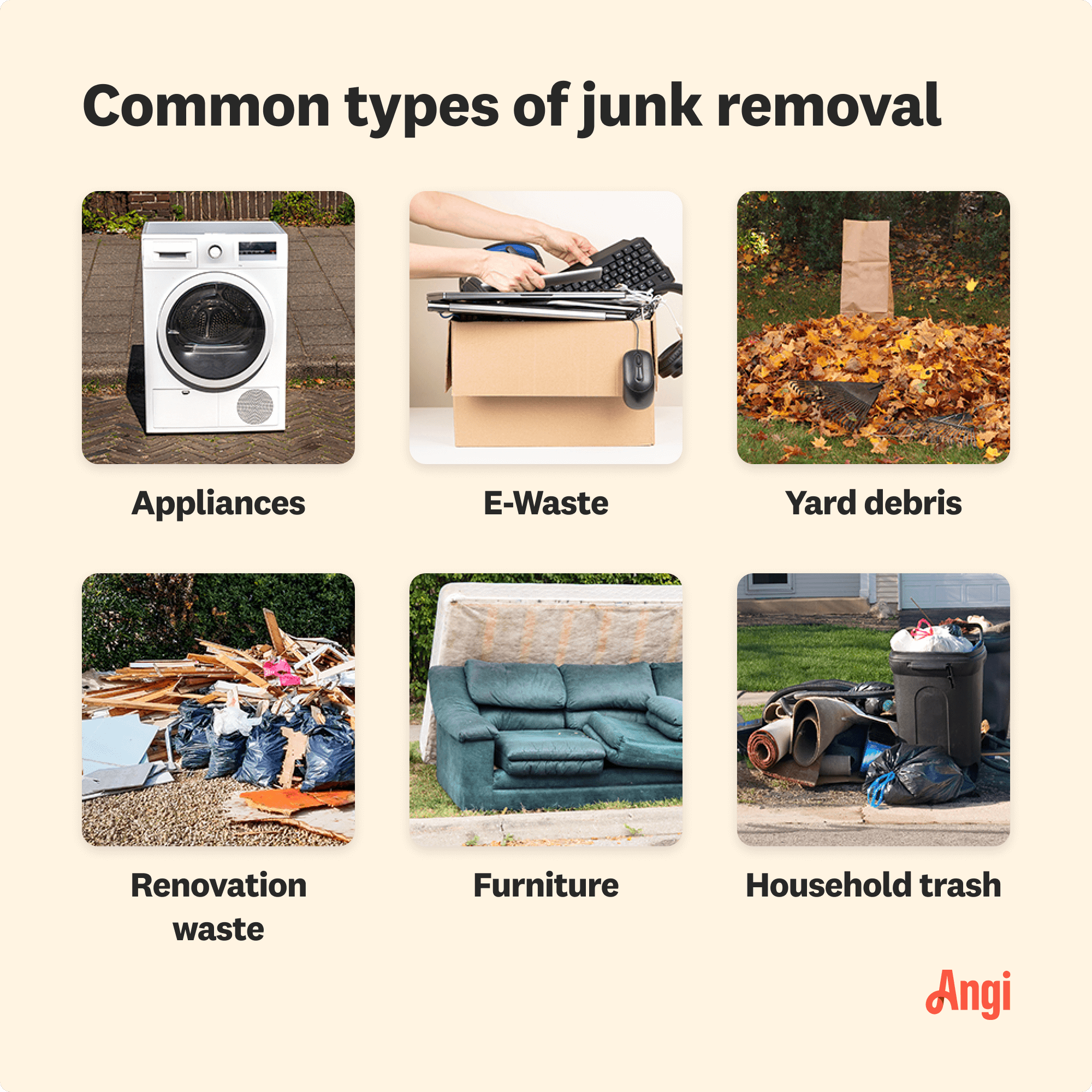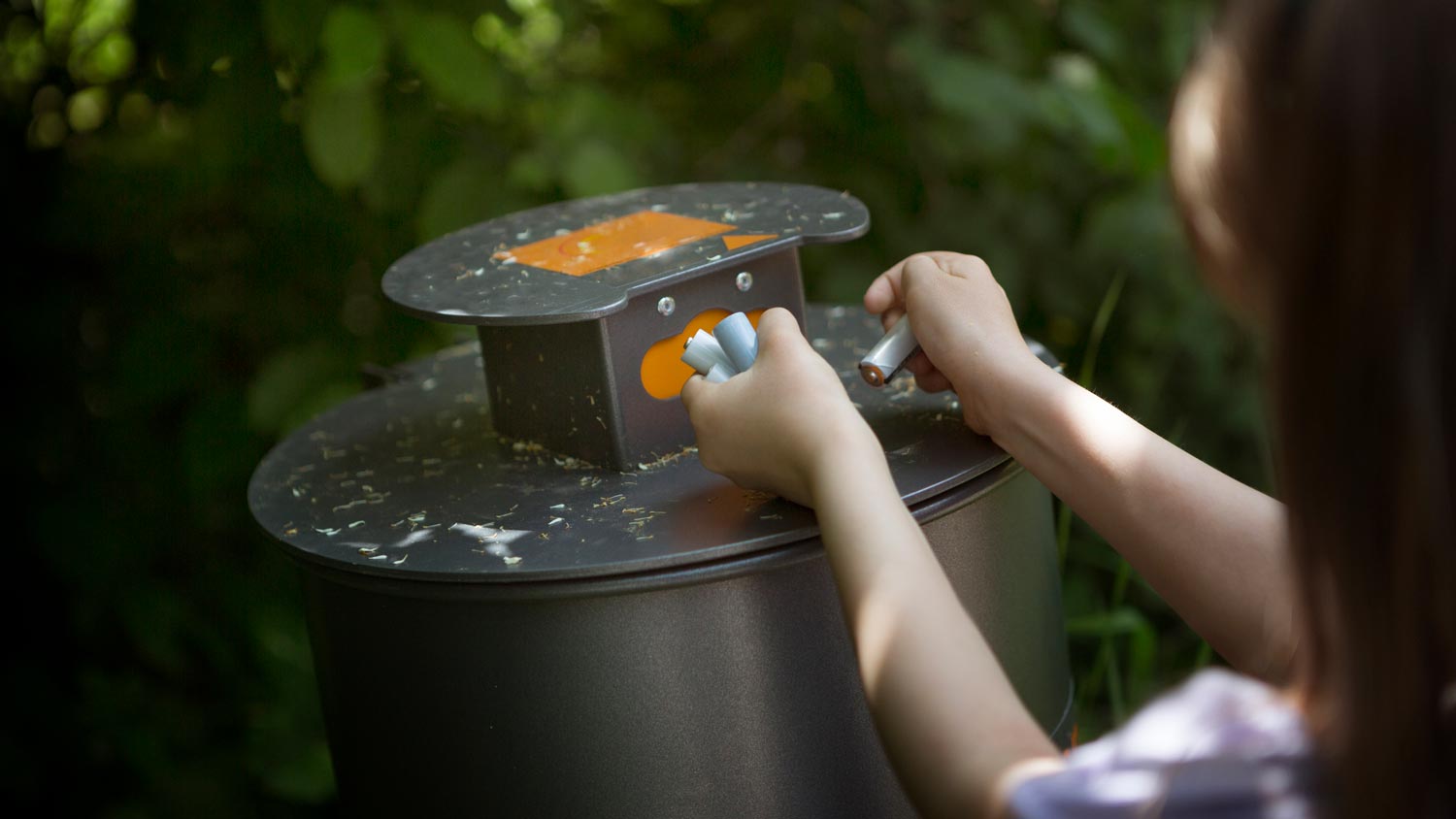
Mattresses are considered hazardous waste, so you’ll likely have to pay disposal fees. Use this guide on mattress removal costs to see what your total will be.
Taking out the bins is just one of many options


While professional junk removal costs $240 on average, it saves significant time and energy.
Hiring a professional is often more cost-effective than renting a dumpster for an extended period.
It can be dangerous to dispose of certain types of trash, such as large appliances or hazardous waste.
A local garbage removal company will help sort what can be thrown out, recycled, and repurposed.
Taking out the trash is one of those things that seems simple enough—at least until you’re faced with a large item you aren’t quite sure how to get rid of. Whether you’re preparing for a move and trying to unload some of your stuff before you pack up or you are looking for more eco-friendly ways to get rid of certain items, it’s a good idea to know your options.
The following guide breaks down eight ways to dispose of just about anything so you never have to wonder how to get rid of trash again.
Getting rid of trash properly is better for the health of the environment and your community than doing so improperly. You’ll also likely be subject to fines and penalties if caught improperly disposing of trash.
The best way to get rid of trash and junk will depend on how much you have, the size of the junk, and whether it includes hazardous materials. Here are eight ways to get rid of junk:
Placing trash in the bins outside your home for your local garbage collection service to pick up is perhaps the most obvious way to get rid of common household trash. As long as you observe certain regulations—like ensuring that your bin is positioned correctly, that it doesn’t contain any hazardous waste or unapproved objects, and that it’s not over the local weight limit—you shouldn’t have any issues.
Sometimes curbside pickup isn’t an option, as with certain large, heavy items—or hey, maybe you just forgot to put your bins out. You still have a few options if you miss trash day, like dropping off your waste at a landfill.

If you have a lot of trash to dispose of—more than your bins can contain—renting a dumpster might be worthwhile. This is also a good option when you have a lot of objects that aren’t accepted with typical waste, like electronic objects and large construction items. The cost to rent a dumpster can range from $200 to $800, depending on its size. And keep in mind that this service is different from junk hauling in that the company will drop the dumpster off at your home, but you’ll have to do the work yourself.

If you have a lot of stuff to clear out before a move, consider calling your local junk haulers or removal service. These pros will do all the work of taking the trash out of your home, sorting it correctly, and taking it to the appropriate drop-off zones—so you can focus on packing what remains.
In general, the cost of junk removal is $240 on average but can range anywhere from $60 to $600—which may still be less expensive than renting a dumpster and doing the work yourself. When searching for a junk hauling company, ask around about what they will and won’t take. Certain items, like tires and hazardous waste, aren’t always accepted, so you’ll need to figure out what to do with them yourself.

Get to know which objects are deemed hazardous waste. This includes things like open paint cans, batteries, mineral spirits, propane, and anything else that produces toxic fumes or is flammable.
While there are some workarounds for things like mineral spirits—which can be combined with cat litter, left out to dry in a well-ventilated space, and thrown out with your normal trash—you’ll be better off arranging to have such objects picked up or dropped off with a local hazardous waste collection service.
To find one near you, contact your local government or use the Environmental Protection Agency’s search engine to locate one. And before scheduling a pick-up or drop-off, give them a ring to find out what they do and don’t accept and the best way to package it to limit associated risks.
Whenever you’re thinking of throwing something away, take a step back and consider whether or not it’s possible to reuse or repurpose it. Things like leftover or semi-used wood boards from DIY projects can almost always find another use—whether that’s for heating up your barbecue, crafting, or small repairs.
Similarly, things like empty glass bottles and tires can be used for building projects, like constructing a garden bed or providing wall support for a new structure. Even leftover plastic can be compacted to create plastic “bricks” that are suitable for building.

Although it’s easy to assume that you can throw any and all paper, plastic, glass, and metal into the recycling bin and call it a day, recycling isn’t that simple. Firstly, what you can and can’t recycle varies from one place to the next, so look up your state and local recycling laws to find out what is and isn’t accepted.
Next, get to know what things you can recycle and under what circumstances. The majority of paper, metal, and glass objects are fair game unless they are too heavily soiled. However, the conversation regarding plastic is more complicated.
Plastic types 1 and 2 are almost always accepted because of their chemical structures and because they can more easily be processed by recycling facilities. On the flip side, plastic types 3, 4, 5, 6, and 7—or single-use plastics as they’re more commonly known—can’t be repurposed and will often end up at a landfill even if you do send them in with the rest of your recyclables. You can find out which is which by looking for a triangular figure with a number in the center, usually located at the bottom of a bottle or package.
Finally, before throwing these items in the bin or hauling them off, sort them into their respective categories, clean off any debris, and remove caps or lids to throw out with your normal trash.
Composting is only an option for biodegradable waste like food scraps; even then, there are restrictions. For example, it’s not advised to add animal waste—like leftover meat or pet droppings—to your at-home compost pile because this can attract pests and inhibit proper decomposition.
If you do decide to compost, know your options. While at-home composting is suitable if you have the space, you may be disinclined to do it if your square footage is limited or you don’t have outdoor access and would prefer not to stink up your house. Many cities across the country now offer bio-waste drop-off and pick-up services, so first, find out if that’s possible from your local government. Or look into purchasing an indoor composting system that’s designed to limit odors.
If the amount of trash you create is weighing on you, learning how to reduce household waste will take a load off—literally and figuratively. Start by keeping track of what you buy and use and making the necessary adjustments. For example, you could begin by swapping paper towels for reusable, machine-washable options or using a compostable plastic wrap instead of your usual disposable go-to. Even bringing your own bag to the grocery store will make a dent over time.
Make sure it’s actually junk: Before you dispose of your trash, be sure it’s actually trash and not something that can be sold, donated, or given to a friend or family member.
Sort things: Before you decide how to dispose of your trash, sort it out to ensure each item is being disposed of properly.
Repurpose: Upcycling is a great way to reuse old furniture, broken tiles, wood scraps, and other household waste. Flex your creative muscles!
Recycle: Lots of materials can be recycled if you take them to the right disposal facility. Research your municipal guidelines and call around to find a drop-off location.
Both removing junk on your own and hiring a pro are viable options. If you are physically able and have the appropriate tools to dispose of your trash on your own, then it’s a good chance to save some money. However, if you aren't able to safely dispose of junk on your own, whether due to physical limitations or improper receptacles for things like hazardous waste, then hiring a garbage removal service near you is the way to go.
From average costs to expert advice, get all the answers you need to get your job done.

Mattresses are considered hazardous waste, so you’ll likely have to pay disposal fees. Use this guide on mattress removal costs to see what your total will be.

Get clear answers on oil tank removal costs, including average prices, key factors, and ways to save. Learn what impacts your project and how to budget.

Need to get rid of paint, solvents, or other chemicals? Use this guide on hazardous waste disposal costs to see what professional removal will cost.

Stains and paints are considered hazardous waste. Learn how to dispose of wood stain safely and the best way to store leftovers between your DIY projects.

Fire extinguishers don’t last forever, but you can’t just throw them in the trash. Learn how to dispose of a fire extinguisher safely and correctly.

Replacing outdated tile flooring is exciting, but read these tips first if you need to know how to dispose of tile in an environmentally friendly way.